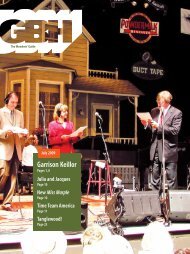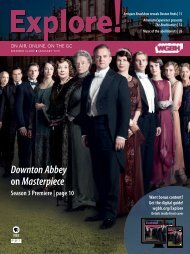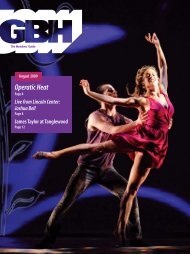Download program notes and libretto - WGBH
Download program notes and libretto - WGBH
Download program notes and libretto - WGBH
You also want an ePaper? Increase the reach of your titles
YUMPU automatically turns print PDFs into web optimized ePapers that Google loves.
court; thankfully, some of his compositions from other<br />
productions have survived. It is from these surviving works<br />
that we have chosen the music for the ballets at the end of<br />
Act I (Ballo de Cacciatori), Act II (Ballo de’ Pastori), <strong>and</strong><br />
for the Adoration dances in Act II, Scene IV. The final<br />
chaconne in Act III, added for the Ballo di Soldati<br />
Festeggianti, was composed by Steffani himself for Enrico<br />
Leone (1689). Again, in the style of the French, ballets were<br />
called for at the end of each act, <strong>and</strong> d’Ardespin’s music<br />
was written in the French style. There are also arias within<br />
the opera that lend themselves beautifully to<br />
“divertissement” moments; whenever appropriate, we have<br />
included dance in those scenes.<br />
In terms of our choreographic aims, we first investigated<br />
the apparent French influence at Max Emanuel’s court; we<br />
particularly looked to the French theorists <strong>and</strong> dancing<br />
masters of the seventeenth <strong>and</strong> early eighteenth centuries.<br />
Along these lines, we are indebted to the wonderful<br />
research by Carol Marsh <strong>and</strong> Rebecca Harris-Warrick on<br />
Jean Favier’s choreography for Le Mariage de la Grosse<br />
Cathos (1688). It is unusual to have so much information<br />
about the original choreography from a particular<br />
spectacle, <strong>and</strong> especially fortuitous that this comic<br />
masquerade was created in the same year as Niobe, albeit<br />
in France. Through their detailed study we gained insight<br />
into what steps <strong>and</strong> step patterns were in practice that year<br />
as well as ideas for spatial patterns for the group<br />
choreographies.<br />
We have also turned to Raoul Auger Feuillet’s<br />
Chorégraphie, ou l’art de décrire la danse (Paris, 1700), an<br />
indispensable guide for today’s early dance specialists as<br />
well to the dancing masters of eighteenth-century Europe.<br />
Feuillet’s book not only instructed the reader how to<br />
decipher the system of dance notation most widely used<br />
<strong>and</strong> published in the eighteenth century, but included<br />
choreographies from Guillaume-Louis Pécour, whom<br />
f e s t i va l o p e ra<br />
François Rodier may have met or studied with on his trip<br />
to Paris. Noting its importance to the art of dance, the<br />
German dancing master, Gottfried Taubert, included a<br />
German translation of Feuillet’s treatise in his own tome,<br />
Rechtschaffener Tantzmeister (The Worthy Dancing<br />
Master, Leipzig, 1717).<br />
Interestingly, in the first quarter of the eighteenth century,<br />
many dance treatises were published in German by<br />
German, Italian, <strong>and</strong> French dancing masters, perhaps<br />
signaling a rise in the popularity of dancing at the German<br />
courts. Amongst the surviving treatises are an interesting<br />
array of authors <strong>and</strong> perspectives on theatrical <strong>and</strong><br />
ballroom dancing, including Louis Bonin’s Die neueste Art<br />
zur galanten und theatralischen Tantz-Kunst (The newest<br />
way of going about the galant <strong>and</strong> theatrical Art of Dance,<br />
Frankfurt, 1711), Gregorio Lambranzi’s Die neue und<br />
curieuse theatralische tantz-Schul (The New <strong>and</strong> Curious<br />
School of Theatrical Dancing, Nuremberg, 1716), <strong>and</strong><br />
Taubert’s treatise, already mentioned above.<br />
We were specifically interested in what these dancing<br />
masters had to say on the differences between la belle<br />
danse, or ballroom dancing, <strong>and</strong> le ballet sérieux, the<br />
serious <strong>and</strong> theatrical style of dancing. Both Bonin <strong>and</strong><br />
Taubert wrote about what steps were more appropriate for<br />
le ballet sérieux <strong>and</strong> their suggestions included complex<br />
enchâinements (linked steps) <strong>and</strong> higher jumps, as well as<br />
the usage of higher movement of the arms. We have<br />
incorporated these ideas while also placing emphasis on<br />
our desire that each of the dancers’ steps <strong>and</strong> gestures be<br />
representative of the characters <strong>and</strong> passions they will<br />
portray on the stage—our poetic ode to the ideals <strong>and</strong><br />
wishes of the early dancing masters who prized invention,<br />
proportion, <strong>and</strong> spectacle in their own works. ■<br />
—Caroline Copel<strong>and</strong><br />
145<br />
2 0 1 1 b o s t o n e a r l y m u s i c f e s t i v a l<br />
NIOBE, REGINA DI TEBE

















